Influence of Topographic Shading on the Mass Balance of the High Mountain Asia Glaciers
Abstract
:1. Introduction
2. Materials and Methods
2.1. Study Area
2.2. Data
2.3. Topographic Shading Calculation
2.3.1. Solar Declination
2.3.2. Hour Angle
2.3.3. Topographic Shading of Glaciers
- Data preprocessing
- 2.
- Determine whether a grid is self-shading
- 3.
- Determine whether the solar beam is obscured by another DEM grid.
3. Results
3.1. The Topographic Shading Area Differences between Each Region of HMA
3.2. Altitudinal Distribution of Glacier Shading Areas
3.3. The Relationship between Glacier Area and Shading Area Percentage
3.4. Glacier Shading Ratios Beneath the Median Elevation
3.5. The Effect of Topographic Shading on the Glacier Mass Balance
4. Discussion
4.1. Factors Influencing Glacier Mass Balance
4.2. Comparison to Topographic Shading Estimates
4.3. Uncertainty in Topographic Shading and Mass Balance Data
5. Conclusions
Author Contributions
Funding
Data Availability Statement
Conflicts of Interest
References
- Immerzeel, W.W.; Bierkens, M.F.P. Asia’s water balance. Nat. Geosci. 2012, 5, 841–842. [Google Scholar]
- Farinotti, D.; Huss, M.; Fürst, J.J.; Landmann, J.M.; Machguth, H.; Maussion, F.; Pandit, A. A consensus estimate for the ice thickness distribution of all glaciers on Earth. Nat. Geosci. 2019, 12, 168–173. [Google Scholar] [CrossRef] [Green Version]
- Immerzeel, W.W.; Lutz, A.F.; Andrade, M.; Bahl, A.; Biemans, H.; Bolch, T.; Hyde, S.; Brumby, S.; Davies, B.J.; Elmore, A.C.; et al. Importance and vulnerability of the world’s water towers. Nature 2020, 577, 364–369. [Google Scholar] [CrossRef]
- Pritchard, H.D. Asia’s shrinking glaciers protect large populations from drought stress. Nature 2019, 569, 649–654. [Google Scholar] [CrossRef] [PubMed]
- Biemans, H.; Siderius, C.; Lutz, A.F.; Nepal, S.; Ahmad, B.; Hassan, T.; Von Bloh, W.; Wijngaard, R.R.; Wester, P.; Shrestha, A.B.; et al. Importance of snow and glacier meltwater for agriculture on the Indo-Gangetic Plain. Nat. Sustain. 2019, 2, 594–601. [Google Scholar] [CrossRef]
- Miles, E.; McCarthy, M.; Dehecq, A.; Kneib, M.; Fugger, S.; Pellicciotti, F. Health and sustainability of glaciers in High Mountain Asia. Nat. Commun. 2021, 12, 2868. [Google Scholar] [CrossRef]
- Brun, F.; Berthier, E.; Wagnon, P.; Kääb, A.; Treichler, D. A spatially resolved estimate of High Mountain Asia glacier mass balances from 2000 to 2016. Nat. Geosci. 2017, 10, 668–673. [Google Scholar]
- Yao, T.D.; Thompson, L.; Yang, W.; Yu, W.S.; Gao, Y.; Guo, X.J.; Yang, X.X.; Duan, K.Q.; Zhao, H.B.; Xu, B.Q.; et al. Different glacier status with atmospheric circulations in Tibetan Plateau and surroundings. Nat. Clim. Chang. 2012, 2, 663–667. [Google Scholar] [CrossRef]
- Gardner, A.S.; Moholdt, G.; Cogley, J.G.; Wouters, B.; Arendt, A.A.; Wahr, J.; Berthier, E.; Hock, R.; Pfeffer, W.T.; Kaser, G.; et al. A Reconciled Estimate of Glacier Contributions to Sea Level Rise: 2003 to 2009. Science 2013, 340, 852–857. [Google Scholar] [CrossRef] [Green Version]
- Bhattacharya, A.; Bolch, T.; Mukherjee, K.; King, O.; Menounos, B.; Kapitsa, V.; Neckel, N.; Yang, W.; Yao, T. High Mountain Asian glacier response to climate revealed by multi-temporal satellite observations since the 1960s. Nat. Commun. 2021, 12, 4133. [Google Scholar] [CrossRef]
- Farinotti, D.; Longuevergne, L.; Moholdt, G.; Duethmann, D.; Mölg, T.; Bolch, T.; Vorogushyn, S.; Güntner, A. Substantial glacier mass loss in the Tien Shan over the past 50 years. Nat. Geosci. 2015, 8, 716–722. [Google Scholar] [CrossRef]
- Shean, D.E.; Bhushan, S.; Montesano, P.; Rounce, D.R.; Arendt, A.; Osmanoglu, B. A systematic, regional assessment of High-Mountain Asia glacier mass balance. Front. Earth Sci. 2019, 7, 363. [Google Scholar]
- Farinotti, D.; Immerzeel, W.W.; De Kok, R.J.; Quincey, D.J.; Dehecq, A. Manifestations and mechanisms of the Karakoram glacier Anomaly. Nat. Geosci. 2020, 13, 8–16. [Google Scholar] [CrossRef] [PubMed]
- Dehecq, A.; Gourmelen, N.; Gardner, A.S.; Brun, F.; Goldberg, D.; Nienow, P.W.; Berthier, E.; Vincent, C.; Wagnon, P.; Trouvé, E. Twenty-first century glacier slowdown driven by mass loss in High Mountain Asia. Nat. Geosci. 2019, 12, 22–27. [Google Scholar] [CrossRef]
- Kraaijenbrink, P.; Bierkens, M.F.; Lutz, A.; Immerzeel, W. Impact of a global temperature rise of 1.5 degrees Celsius on Asia’s glaciers. Nature 2017, 549, 257–260. [Google Scholar] [CrossRef]
- Kapnick, S.; Delworth, T.; Ashfaq, M.; Malyshev, S.; Milly, P.C.D. Snowfall less sensitive to warming in Karakoram than in Himalayas due to a unique seasonal cycle. Nat. Geosci. 2014, 7, 834–840. [Google Scholar] [CrossRef]
- Scherler, D.; Bookhagen, B.; Strecker, M.R. Spatially variable response of Himalayan glaciers to climate change affected by debris cover. Nat. Geosci. 2011, 4, 156–159. [Google Scholar] [CrossRef]
- Bolch, T.; Kulkarni, A.; Kääb, A.; Huggel, C.; Paul, F.; Cogley, J.G.; Frey, H.; Kargel, J.S.; Fujita, K.; Scheel, M.; et al. The State and Fate of Himalayan Glaciers. Science 2012, 336, 310–314. [Google Scholar] [CrossRef] [Green Version]
- Brun, F.; Wagnon, P.; Berthier, E.; Jomelli, V.; Maharjan, S.B.; Shrestha, F.; Kraaijenbrink, P. Heterogeneous Influence of Glacier Morphology on the Mass Balance Variability in High Mountain Asia. J. Geophys. Res. Earth Surf. 2019, 124, 1331–1345. [Google Scholar] [CrossRef]
- Wang, R.; Liu, S.; Shangguan, D.; Radić, V.; Zhang, Y. Spatial Heterogeneity in Glacier Mass-Balance Sensitivity across High Mountain Asia. Water 2019, 11, 776. [Google Scholar] [CrossRef] [Green Version]
- Sakai, A.; Fujita, K. Contrasting glacier responses to recent climate change in high-mountain Asia. Sci. Rep. 2017, 7, 13717. [Google Scholar] [CrossRef] [PubMed]
- Shangguan, D.; Liu, S.; Ding, Y.; Li, J.; Zhang, Y.; Ding, L.; Wang, X.; Xie, C.; Li, G. Glacier changes in the west Kunlun Shan from 1970 to 2001 derived from Landsat TM/ETM+ and Chinese glacier inventory data. Ann. Glaciol. 2007, 46, 204–208. [Google Scholar] [CrossRef] [Green Version]
- Mölg, T.; Maussion, F.; Yang, W.; Scherer, D. The footprint of Asian monsoon dynamics in the mass and energy balance of a Tibetan glacier. Cryosphere 2012, 6, 1445–1461. [Google Scholar] [CrossRef] [Green Version]
- Arnold, N.S.; Willis, I.C.; Sharp, M.J.; Richards, K.S.; Lawson, W.J. A distributed surface energy-balance model for a small valley glacier. I. Development and testing for Haut Glacier d’Arolla, Valais, Switzerland. J. Glaciol. 1996, 42, 77–89. [Google Scholar]
- Hock, R.; Holmgren, B. A distributed surface energy-balance model for complex topography and its application to Storglaciren, Sweden. J. Glaciol. 2005, 51, 25–36. [Google Scholar]
- Anslow, F.S.; Hostetler, S.; Bidlake, W.R.; Clark, P.U. Distributed energy balance modeling of South Cascade Glacier, Washington and assessment of model uncertainty. J. Geophys. Res. Earth Surf. 2008, 113, F0201. [Google Scholar] [CrossRef] [Green Version]
- Jiang, X.; Wang, N.; He, J.; Wu, X.; Song, G. A distributed surface energy and mass balance model and its application to a mountain glacier in China. Chin. Sci. Bull. 2010, 55, 2079–2087. [Google Scholar] [CrossRef]
- DeBeer, C.M.; Sharp, M.J. Topographic influences on recent changes of very small glaciers in the Monashee Mountains, British Columbia, Canada. J. Glaciol. 2009, 55, 691–700. [Google Scholar] [CrossRef] [Green Version]
- York, A. Comparing Geodetically Derived Mass Balances among Three Small Glaciers, South Coast Mountains, British Columbia. Ph.D. Thesis, Northern Arizona University, Flagstaff, AZ, USA, 2013. [Google Scholar]
- Evans, I.S. Local aspect asymmetry of mountain glaciation: A global survey of consistency of favoured directions for glacier numbers and altitudes. Geomorphology 2006, 73, 166–184. [Google Scholar] [CrossRef]
- Burrough, P.A.; McDonnell, R.A.; Lloyd, C.D. Principles of Geographical Information Systems; Oxford University Press: Oxford, UK, 1998. [Google Scholar]
- Regine, H. A distributed temperature-index ice- and snowmelt model including potential direct solar radiation. J. Glaciol. 1999, 45, 101–111. [Google Scholar]
- Li, X.; Cheng, G.; Chen, X.; Lu, L. Modification of solar radiation model over rugged terrain. Chin. Sci. Bull. 1999, 44, 1345–1349. [Google Scholar] [CrossRef]
- Olson, M.; Rupper, S. Impacts of topographic shading on direct solar radiation for valley glaciers in complex topography. Cryosphere 2019, 13, 29–40. [Google Scholar] [CrossRef] [Green Version]
- Hock, R.; Tijm-Reijmer, C. A mass-balance, glacier runoff and mutli-layer snow model. In Program Documentation and Users Manual; University of Alaska Fairbanks: Fairbanks, AK, USA; Utrecht University: Utrecht, The Netherlands, 2012. [Google Scholar]
- Hock, R.; Noetzli, C. Areal melt and discharge modelling of Storglaciären, Sweden. Ann. Glaciol. 1997, 24, 211–216. [Google Scholar]
- Liang, L.; Cuo, L.; Liu, Q. The energy and mass balance of a continental glacier: Dongkemadi Glacier in central Tibetan Plateau. Sci. Rep. 2018, 8, 12788. [Google Scholar] [PubMed]
- Rgi, C.; Nosenko, G. Randolph Glacier Inventory(RGI)-A Dataset of Global Glacier Outlines: Version6.0; Technical Report; Global Land Ice Measurements from Space: Boulder, CO, USA, 2017. [Google Scholar]
- Sorg, A.; Bolch, T.; Stoffel, M.; Solomina, O.; Beniston, M. Climate change impacts on glaciers and runoff in Tien Shan (Central Asia). Nat. Clim. Chang. 2012, 2, 725–731. [Google Scholar] [CrossRef]
- Guo, W.; Liu, S.; Xu, J.; Wu, L.; Shangguan, D.; Yao, X.; Wei, J.; Bao, W.; Yu, P.; Liu, Q.; et al. The second Chinese glacier inventory: Data, methods and results. J. Glaciol. 2015, 61, 357–372. [Google Scholar] [CrossRef] [Green Version]
- Pfeffer, W.T.; Arendt, A.A.; Bliss, A.; Bolch, T.; Cogley, J.G.; Gardner, A.; Hagen, J.-O.; Hock, R.; Kaser, G.; Kienholz, C.; et al. The Randolph Glacier Inventory: A globally complete inventory of glaciers. J. Glaciol. 2014, 60, 537–552. [Google Scholar] [CrossRef] [Green Version]
- Jarvis, A.; Reuter, H.I.; Nelson, A.; Guevara, E. Hole-Filled SRTM for the Globe Version 4. Available from the CGIAR-CSI SRTM 90 m Database. 2008. Available online: http://srtm.csi.cgiar.org (accessed on 1 February 2022).
- Rolstad, C.; Haug, T.; Denby, B. Spatially integrated geodetic glacier mass balance and its uncertainty based on geostatistical analysis: Application to the western Svartisen ice cap, Norway. J. Glaciol. 2009, 55, 666–680. [Google Scholar] [CrossRef] [Green Version]
- Brock, B.W.; Arnold, N.S. A spreadsheet-based (Microsoft Excel) point surface energy balance model for glacier and snow melt studies. Earth Surf. Process. Landf. 2000, 25, 649–658. [Google Scholar] [CrossRef]
- Oke, T. Boundary Layer Climates, 2nd ed.; Routledge: London, UK, 2002. [Google Scholar]
- Walraven, R. Calculating the position of the sun. Sol. Energy 1978, 20, 393–397. [Google Scholar] [CrossRef]
- Holzer, N.; Vijay, S.; Yao, T.; Xu, B.; Buchroithner, M.; Bolch, T. Four decades of glacier variations at Muztagh Ata (eastern Pamir): A multi-sensor study including Hexagon KH-9 and Pléiades data. Cryosphere 2015, 9, 2071–2088. [Google Scholar] [CrossRef] [Green Version]
- Zhu, M.; Yao, T.; Yang, W.; Xu, B.; Wu, G.; Wang, X.; Xie, Y. Reconstruction of the mass balance of Muztag Ata No. 15 glacier, eastern Pamir, and its climatic drivers. J. Glaciol. 2018, 64, 259–274. [Google Scholar] [CrossRef] [Green Version]
- Wu, B. Weakening of Indian summer monsoon in recent decades. Adv. Atmos. Sci. 2005, 22, 21–29. [Google Scholar] [CrossRef]
- Zhao, H.; Xu, B.; Yao, T.; Wu, G.; Lin, S.; Gao, J.; Wang, M. Deuterium excess record in a southern Tibetan ice core and its potential climatic implications. Clim. Dyn. 2012, 38, 1791–1803. [Google Scholar] [CrossRef]
- Liu, X.D.; Chen, B.D. Climatic warming in the Tibetan plateau during recent decades. Int. J. Climatol. 2015, 20, 1729–1742. [Google Scholar]
- Gao, Y.; Chen, F.; Lettenmaier, D.P.; Xu, J.; Xiao, L.; Li, X. Does elevation-dependent warming hold true above 5000 m elevation? Lessons from the Tibetan Plateau. NPJ Clim. Atmos. Sci. 2018, 1, 19. [Google Scholar] [CrossRef]
- Zhang, Y.; Enomoto, H.; Ohata, T.; Kitabata, H.; Kadota, T.; Hirabayashi, Y. Glacier mass balance and its potential impacts in the Altai Mountains over the period 1990–2011. J. Hydrol. 2017, 553, 662–677. [Google Scholar]
- Mölg, T.; Hardy, D.R. Ablation and associated energy balance of a horizontal glacier surface on Kilimanjaro. J. Geophys. Res. 2007, 109, D16104. [Google Scholar]
- Oerlemans, J.; Klok, E. Energy balance of a glacier surface: Analysis of automatic weather station data from the Morteratschgletscher, Switzerland. Arct. Antarct. Alp. Res. 2002, 34, 477–485. [Google Scholar]
- Yang, W.; Guo, X.; Yao, T.; Yang, K.; Zhao, L.; Li, S.; Zhu, M. Summertime surface energy budget and ablation modeling in the ablation zone of a maritime Tibetan glacier. J. Geophys. Res. Earth Surf. 2011, 116. [Google Scholar] [CrossRef]
- Sun, W.; Qin, X.; Ren, J.; Yang, X.; Zhang, T.; Liu, Y.; Cui, X.; Du, W. The Surface Energy Budget in the Accumulation Zone of the Laohugou Glacier No. 12 in the Western Qilian Mountains, China, in Summer 2009. Arct. Antarct. Alp. Res. 2012, 44, 296–305. [Google Scholar] [CrossRef] [Green Version]
- Zhang, G.; Kang, S.; Fujita, K.; Huintjes, E.; Xu, J.; Yamazaki, T.; Haginoya, S.; Wei, Y.; Scherer, D.; Schneider, C.; et al. Energy and mass balance of Zhadang glacier surface, central Tibetan Plateau. J. Glaciol. 2013, 59, 137–148. [Google Scholar] [CrossRef] [Green Version]
- Chen, J.; Qin, X.; Kang, S.; DU, W.; Sun, W.; Liu, Y. Effects of clouds on surface melting of Laohugou glacier No. 12, western Qilian Mountains, China. J. Glaciol. 2018, 64, 89–99. [Google Scholar] [CrossRef] [Green Version]
- Herreid, S.; Pellicciotti, F. The state of rock debris covering Earth’s glaciers. Nat. Geosci. 2020, 13, 621–627. [Google Scholar] [CrossRef]
- Zhang, Y.; Liu, S.; Ding, Y. Glacier meltwater and runoff modelling, Keqicar Baqi glacier, southwestern Tien Shan, China. J. Glaciol. 2007, 53, 91–98. [Google Scholar] [CrossRef] [Green Version]
- Zhang, Y.; Hirabayashi, Y.; Liu, Q.; Liu, S. Glacier runoff and its impact in a highly glacierized catchment in the southeastern Tibetan Plateau: Past and future trends. J. Glaciol. 2015, 61, 713–730. [Google Scholar] [CrossRef] [Green Version]
- Radić, V.; Hock, R. Regional and global volumes of glaciers derived from statistical upscaling of glacier inventory data. J. Geophys. Res. Earth Surf. 2010, 115, F01010. [Google Scholar] [CrossRef]
- Yin, Q.Z.; Wu, Z.P.; Berger, A.; Goosse, H.; Hodell, D. Insolation triggered abrupt weakening of Atlantic circulation at the end of interglacials. Science 2021, 373, 1035–1040. [Google Scholar]

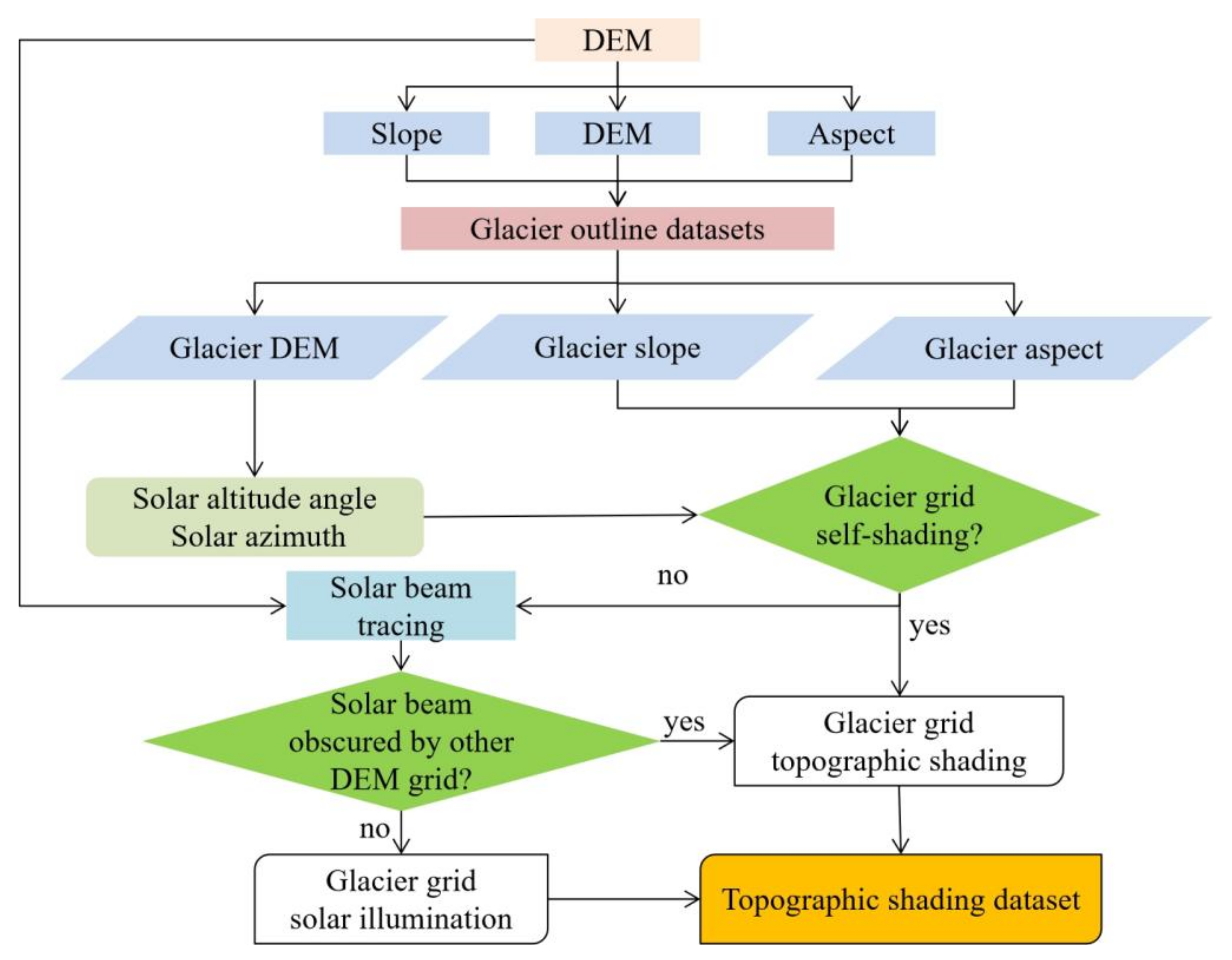
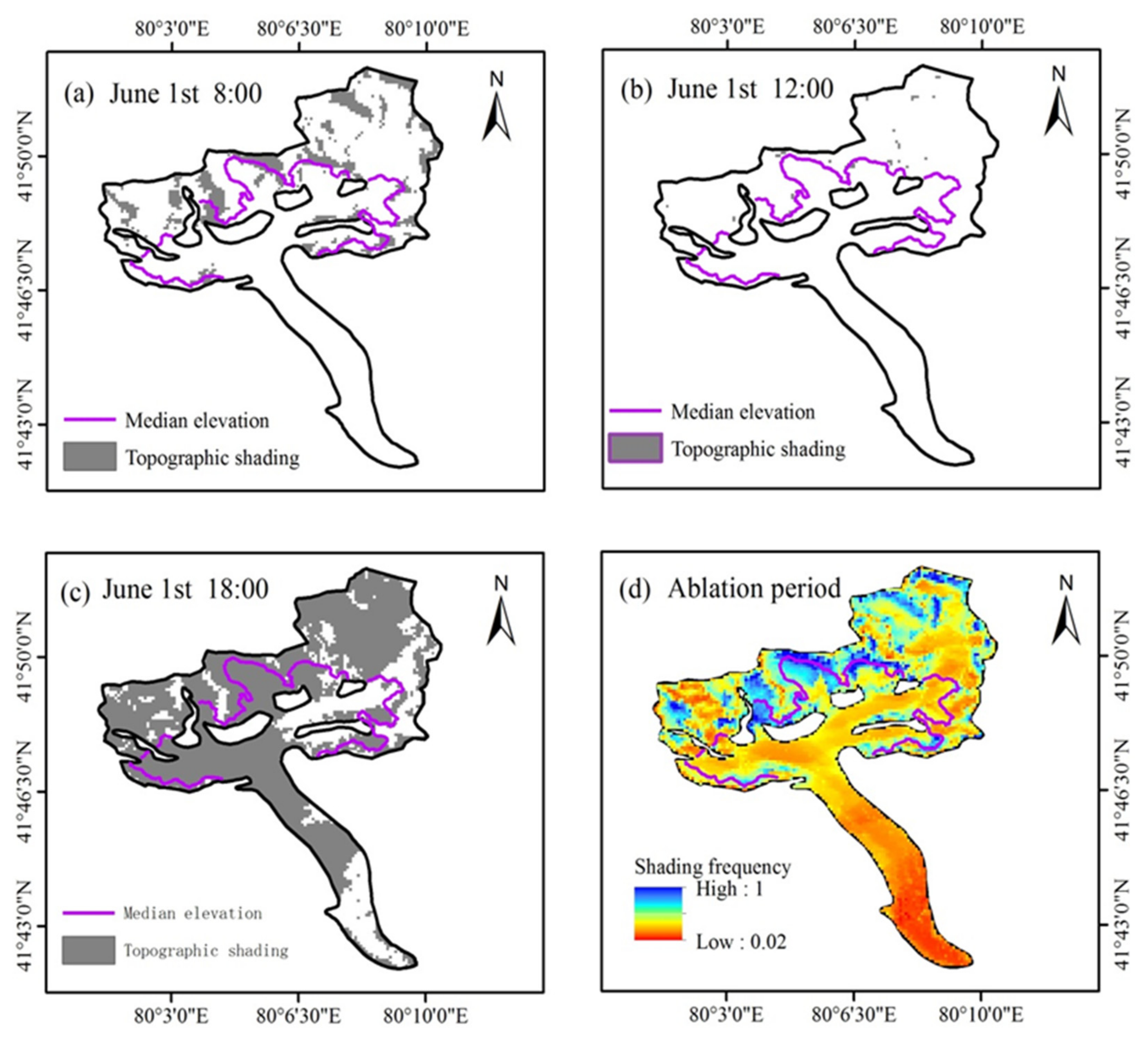
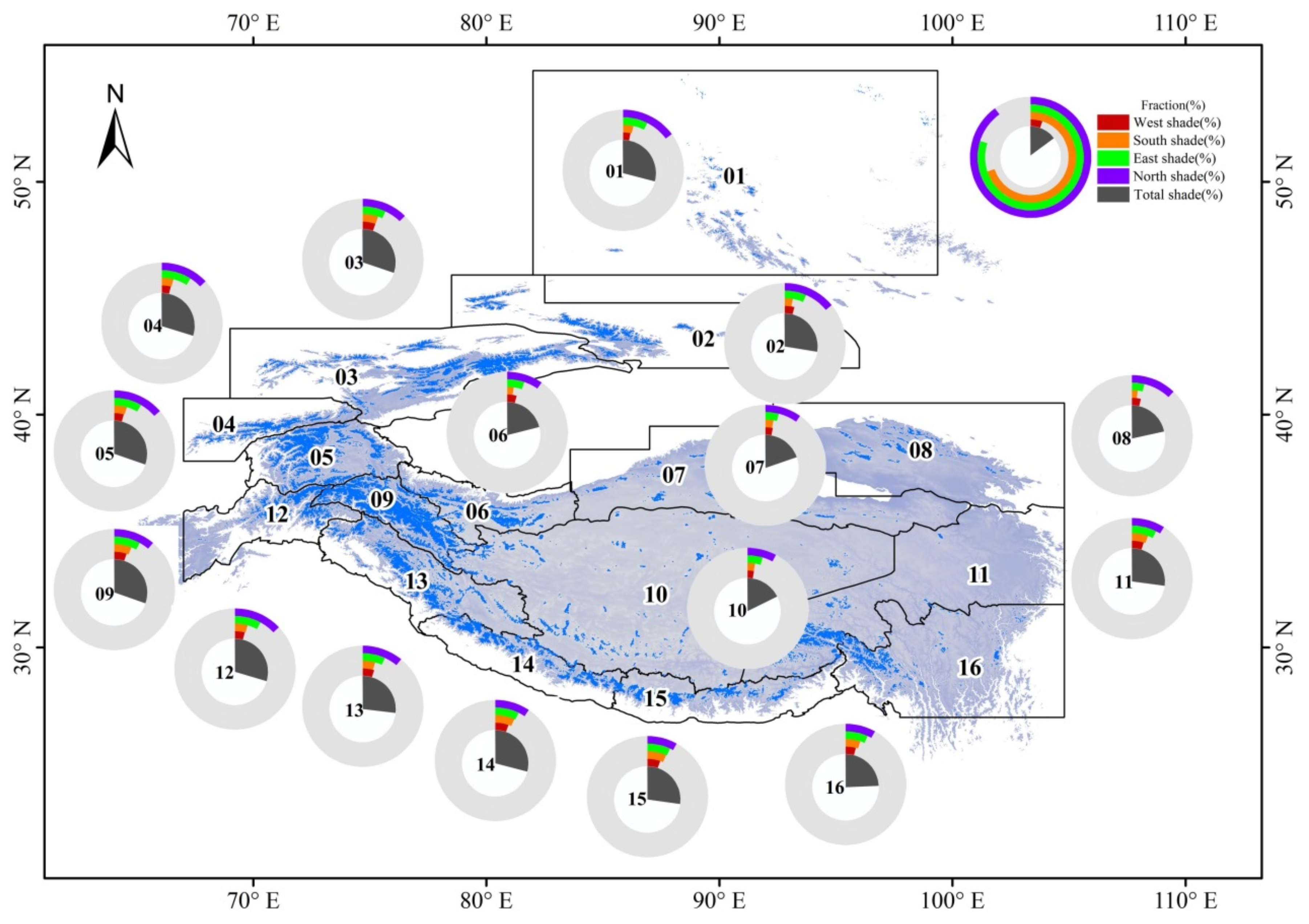
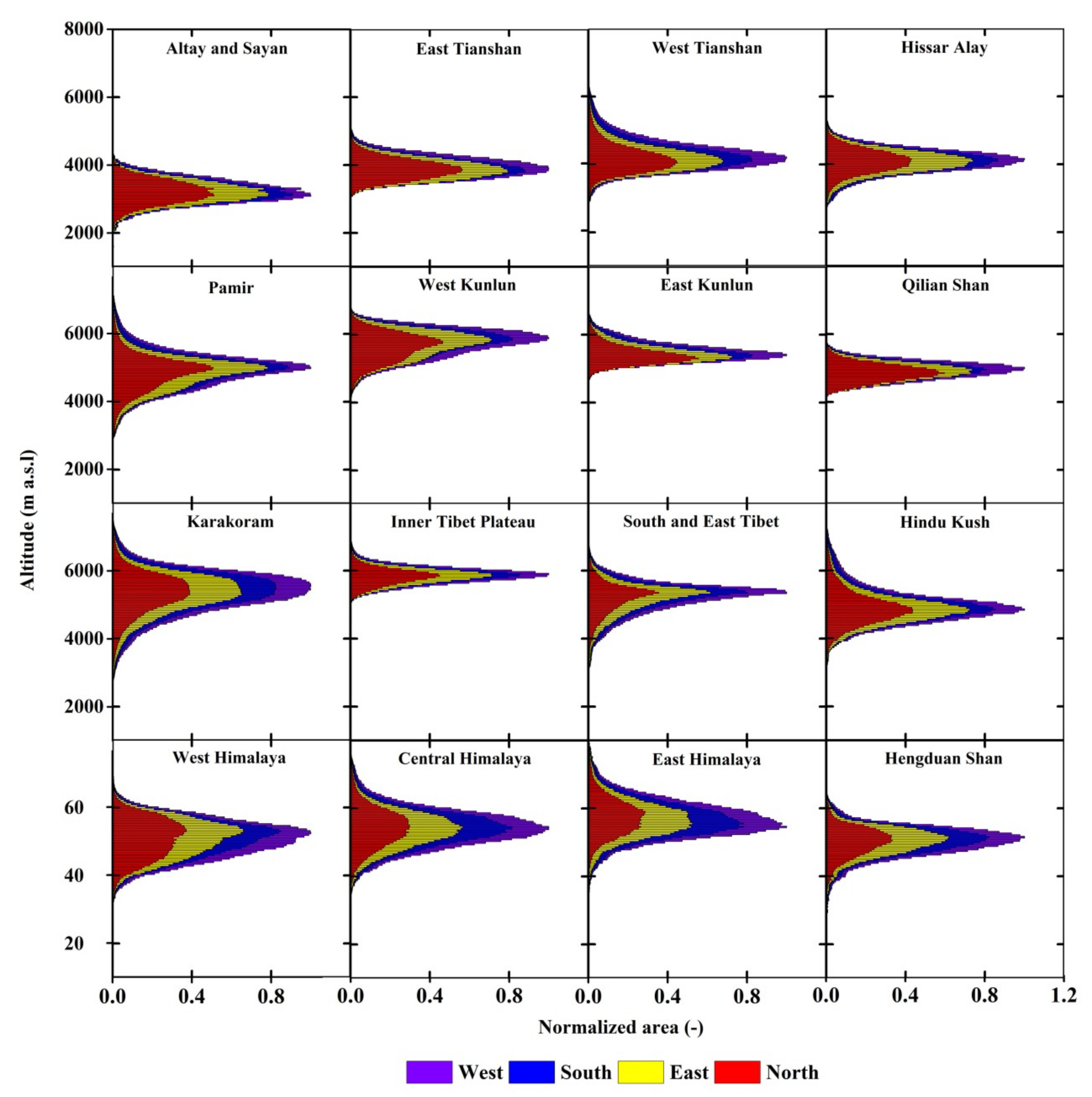
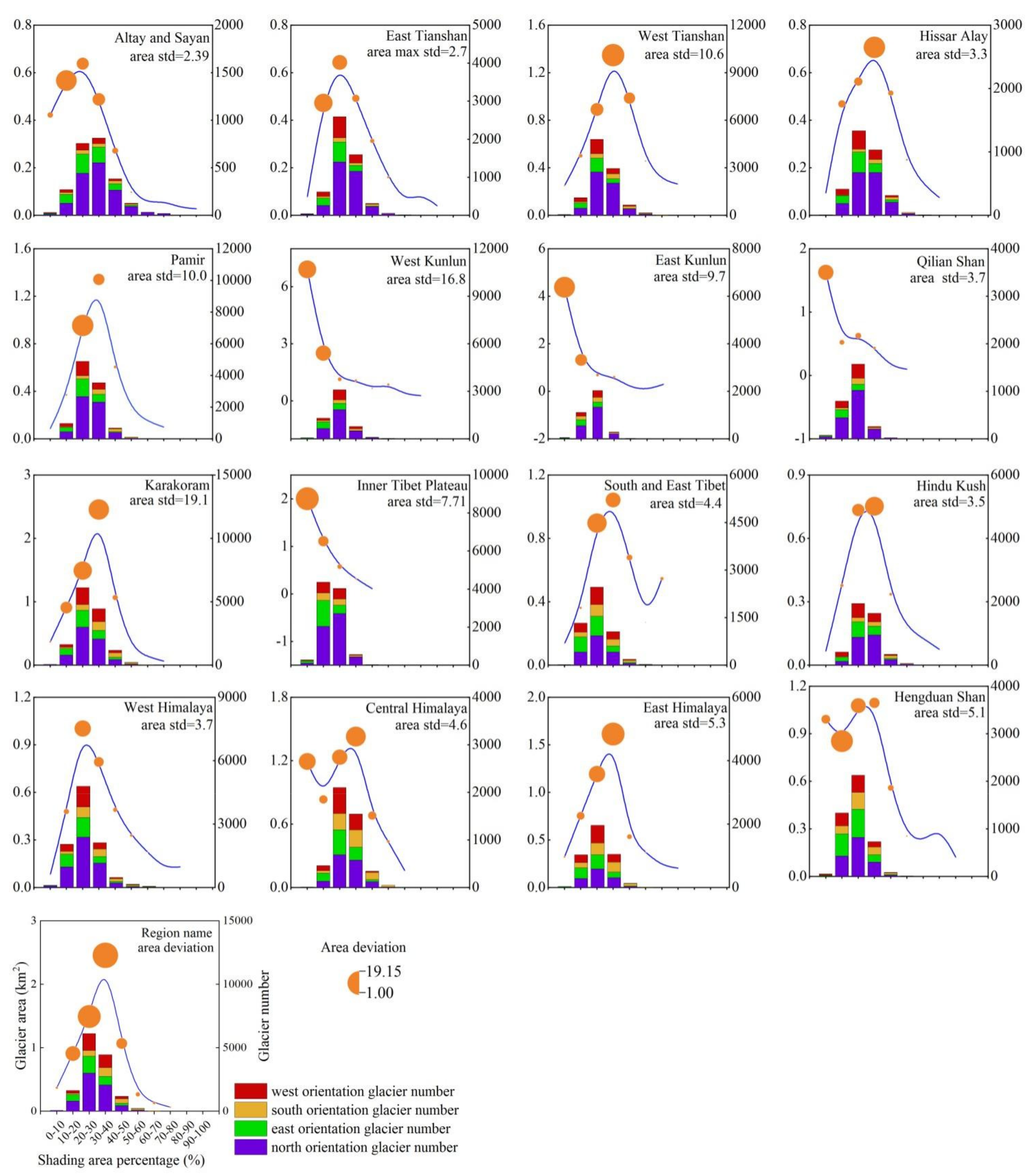
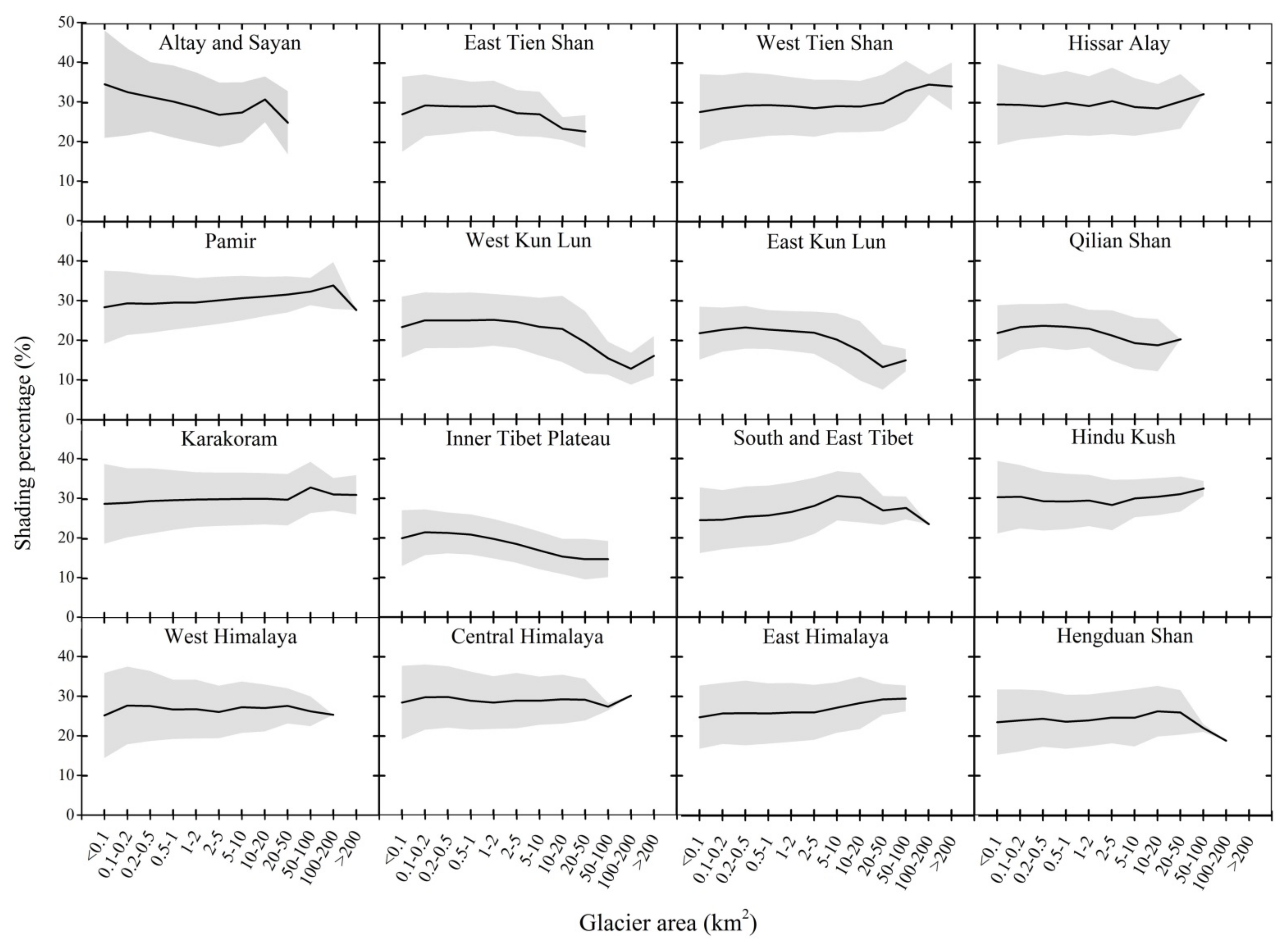
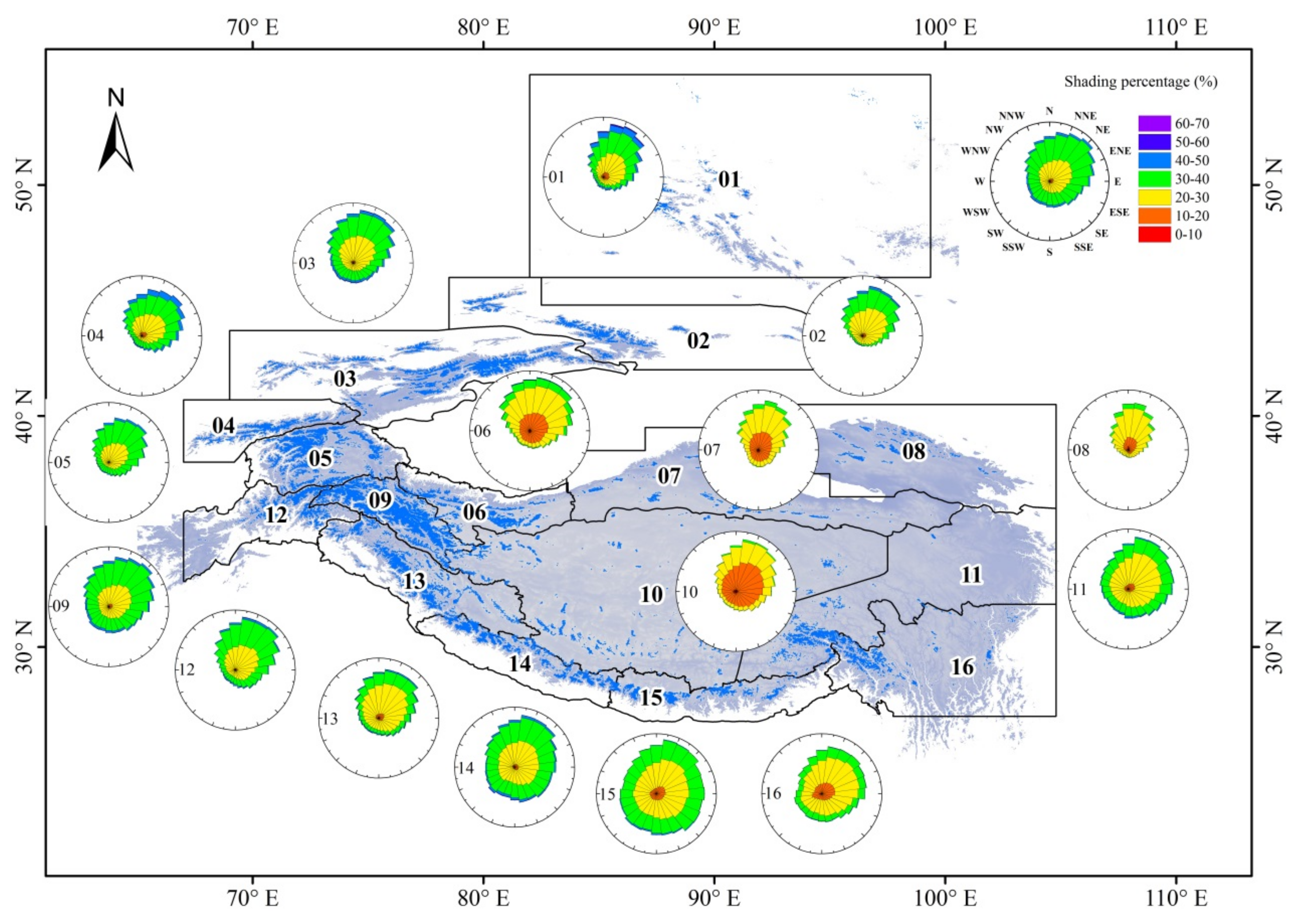
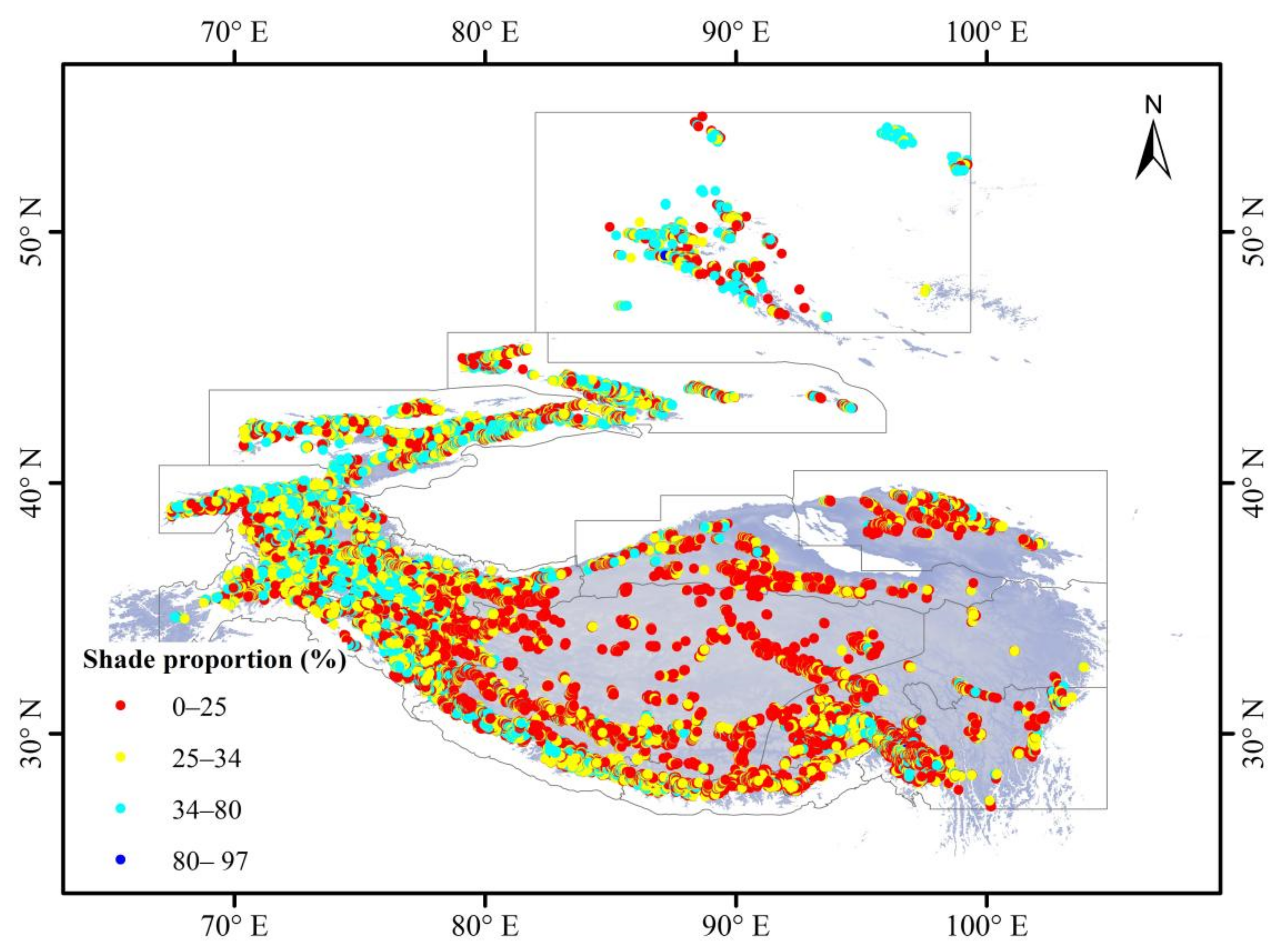

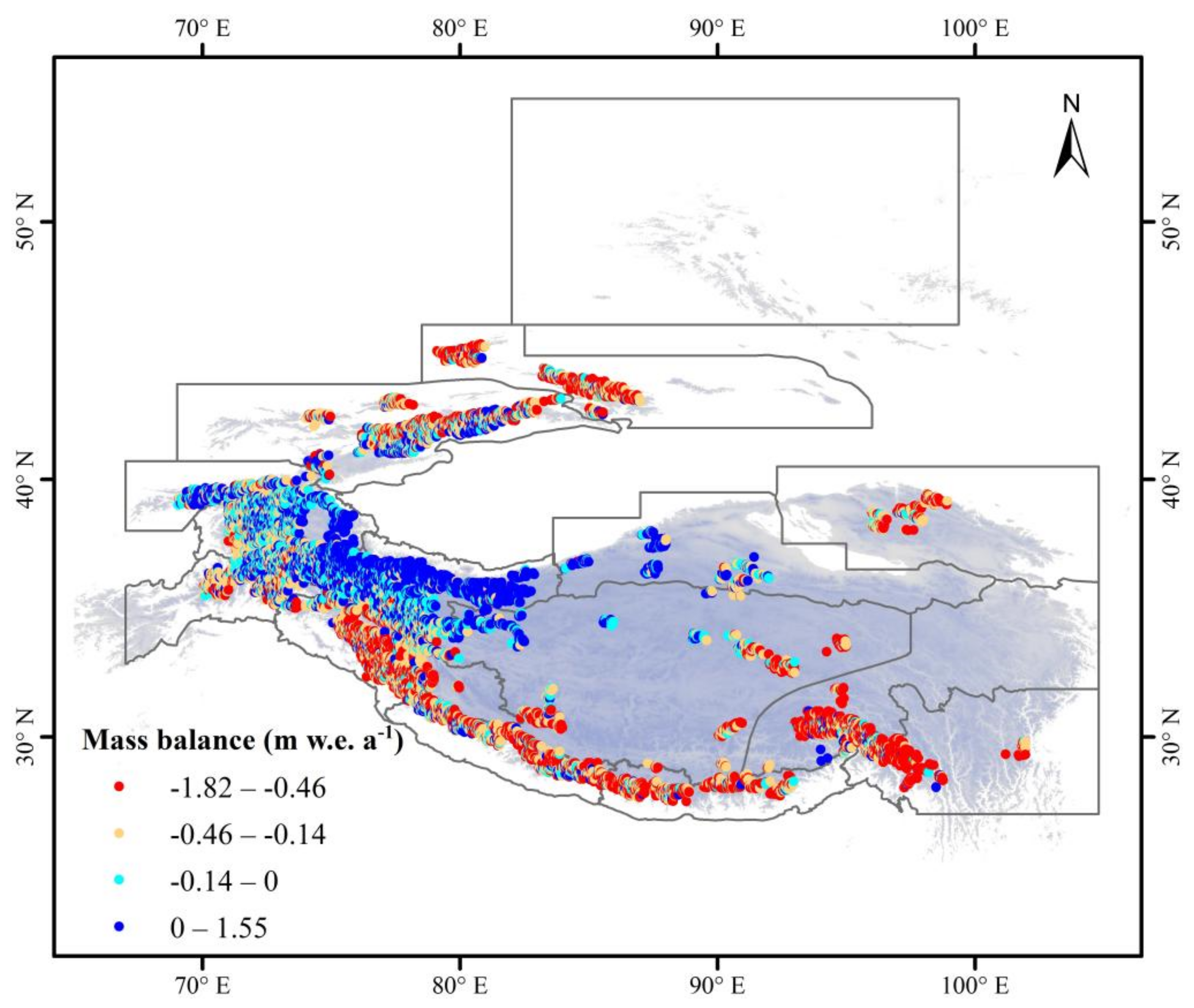
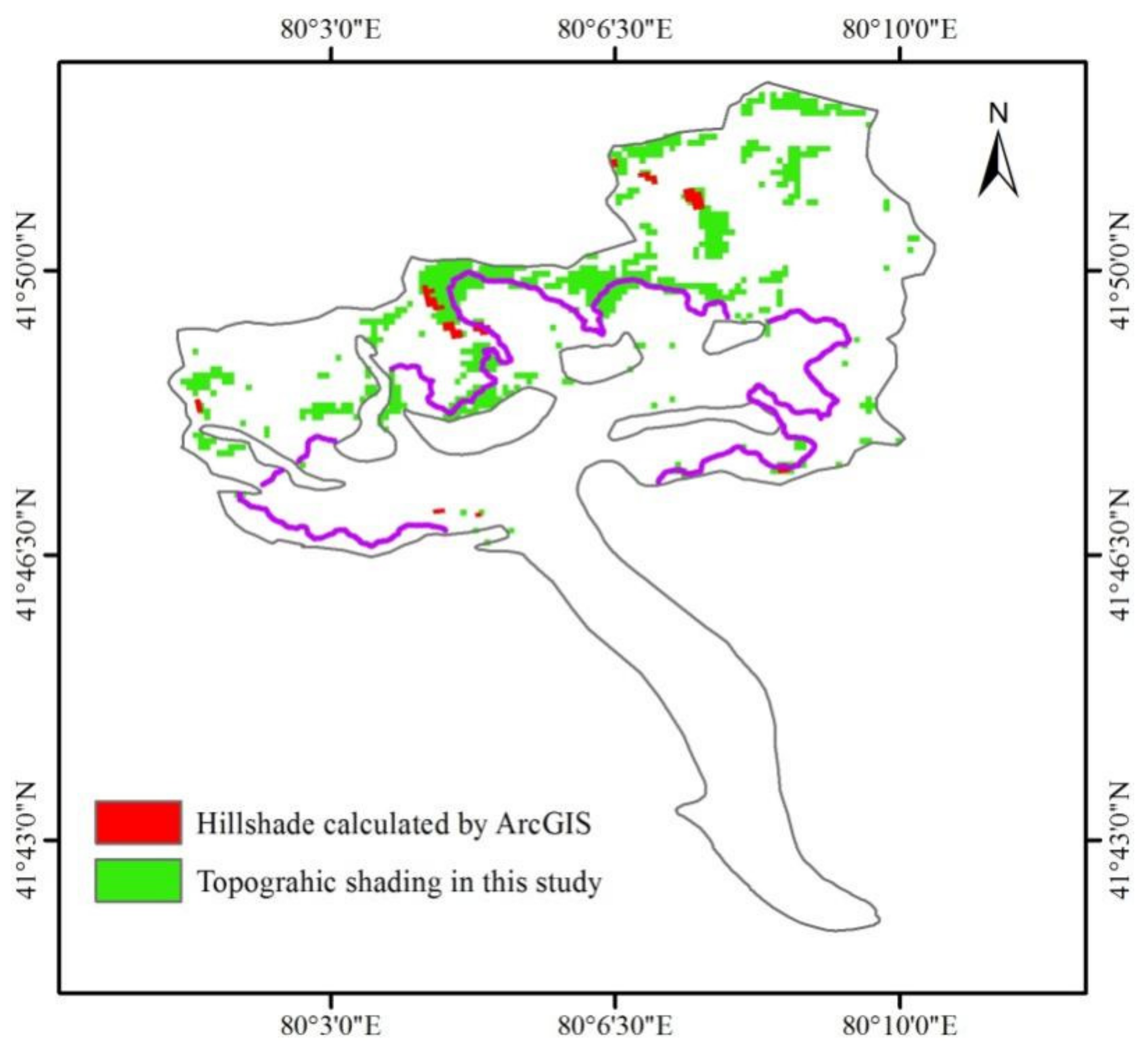
| RGI Region | Nglacier | Anorth (km2) | Aeast (km2) | Asouth (km2) | West (km2) | A (km2) |
|---|---|---|---|---|---|---|
| 01 Altay and Sayan | 2431 | 551.58 | 325.48 | 132.75 | 151.77 | 1161.57 |
| 02 East Tianshan | 5227 | 1373.07 | 665.27 | 292.97 | 521.88 | 2853.18 |
| 03 West Tianshan | 9739 | 3869.71 | 2048.93 | 1555.03 | 2055.02 | 9528.69 |
| 04 Hissar Alay | 3151 | 804.03 | 480.33 | 217.39 | 343.69 | 1845.43 |
| 05 Pamir | 10,233 | 4625.88 | 2520.35 | 1307.45 | 1781.13 | 10,234.80 |
| 06 West Kunlun | 5397 | 3379.15 | 1946.58 | 1064.66 | 1759.46 | 8149.85 |
| 07 East Kunlun | 3519 | 1448.55 | 717.18 | 507.55 | 577.28 | 3250.56 |
| 08 Qilian Shan | 2730 | 869.49 | 337.21 | 144.58 | 285.83 | 1637.10 |
| 09 Karakoram | 13,759 | 8285.10 | 5807.44 | 4308.07 | 4457.47 | 22,858.08 |
| 10 Inner Tibet Plateau | 9365 | 3228.15 | 2122.98 | 1198.37 | 1382.54 | 7932.05 |
| 11 South and East Tibet | 5063 | 1283.68 | 1083.66 | 730.77 | 772.95 | 3871.05 |
| 12 Hindu Kush | 4401 | 1257.87 | 702.68 | 415.83 | 563.01 | 2939.39 |
| 13 West Himalaya | 9829 | 3092.48 | 1844.76 | 1160.46 | 1627.41 | 7725.10 |
| 14 Central Himalaya | 4530 | 1786.11 | 1372.67 | 1165.31 | 1168.30 | 5492.39 |
| 15 East Himalaya | 4237 | 1399.29 | 1277.93 | 1165.56 | 1045.61 | 4888.39 |
| 16 Hengduan Shan | 4354 | 1380.20 | 1274.30 | 884.10 | 846.10 | 4384.70 |
| Total | 97,965 | 38,634.33 | 24,527.73 | 16,250.83 | 19,339.45 | 98,752.33 |
| RGI Region | Pnorth (%) | Peast (%) | Psouth (%) | Pwest (%) | Ptotal (%) |
|---|---|---|---|---|---|
| 01 Altay and Sayan | 14.83 | 7.56 | 3.64 | 3.10 | 29.13 |
| 02 East Tianshan | 14.04 | 6.58 | 2.83 | 4.13 | 27.57 |
| 03 West Tianshan | 12.23 | 7.05 | 5.47 | 5.45 | 30.20 |
| 04 Hissar Alay | 12.79 | 9.09 | 4.11 | 3.80 | 29.79 |
| 05 Pamir | 13.56 | 8.36 | 4.42 | 4.02 | 30.35 |
| 06 West Kunlun | 9.61 | 5.21 | 2.30 | 4.02 | 21.13 |
| 07 East Kunlun | 9.77 | 4.04 | 2.82 | 3.11 | 19.73 |
| 08 Qilian Shan | 12.03 | 3.79 | 2.03 | 3.77 | 21.62 |
| 09 Karakoram | 11.02 | 7.97 | 6.16 | 5.28 | 30.43 |
| 10 Inner Tibet Plateau | 7.77 | 4.62 | 2.66 | 2.71 | 17.76 |
| 11 South and East Tibet | 8.86 | 7.53 | 5.72 | 5.04 | 27.15 |
| 12 Hindu Kush | 12.89 | 8.00 | 4.53 | 4.20 | 29.62 |
| 13 West Himalaya | 10.89 | 6.85 | 4.36 | 4.85 | 26.96 |
| 14 Central Himalaya | 9.29 | 7.24 | 6.85 | 5.69 | 29.07 |
| 15 East Himalaya | 8.00 | 7.00 | 6.72 | 5.50 | 27.23 |
| 16 Hengduan Shan | 8.02 | 6.79 | 5.24 | 4.36 | 24.40 |
| RGI Region | Nglacier | Nnorth | Neast | Nsouth | Nwest | MB (m w.e.) | Area (km2) |
|---|---|---|---|---|---|---|---|
| 01 Altay and Sayan | − | − | − | − | − | − | − |
| 02 East Tianshan | 957 | 570 | 166 | 59 | 162 | −0.47 | 1.254 |
| 03 West Tianshan | 1792 | 1084 | 252 | 189 | 267 | −0.27 | 2.747 |
| 04 Hissar Alay | 479 | 277 | 94 | 38 | 70 | −0.09 | 1.531 |
| 05 Pamir | 2112 | 1275 | 416 | 163 | 258 | −0.10 | 2.59 |
| 06 West Kunlun | 890 | 588 | 111 | 60 | 131 | 0.10 | 4.422 |
| 07 East Kunlun | 344 | 222 | 37 | 44 | 41 | −0.09 | 3.41 |
| 08 Qilian Shan | 328 | 203 | 43 | 27 | 55 | −0.35 | 1.642 |
| 09 Karakoram | 2375 | 1360 | 384 | 250 | 381 | −0.09 | 5.285 |
| 10 Inner Tibet Plateau | 1189 | 705 | 230 | 106 | 148 | −0.26 | 2.712 |
| 11 South and East Tibet | 615 | 213 | 152 | 109 | 141 | −0.68 | 3.058 |
| 12 Hindu Kush | 811 | 389 | 172 | 92 | 158 | −0.17 | 1.8 |
| 13 West Himalaya | 1891 | 976 | 364 | 218 | 333 | −0.49 | 2.215 |
| 14 Central Himalaya | 1099 | 382 | 252 | 211 | 254 | −0.38 | 2.732 |
| 15 East Himalaya | 981 | 298 | 193 | 237 | 253 | −0.48 | 3.018 |
| 16 Hengduan Shan | 850 | 324 | 248 | 136 | 142 | −0.72 | 2.662 |
Publisher’s Note: MDPI stays neutral with regard to jurisdictional claims in published maps and institutional affiliations. |
© 2022 by the authors. Licensee MDPI, Basel, Switzerland. This article is an open access article distributed under the terms and conditions of the Creative Commons Attribution (CC BY) license (https://creativecommons.org/licenses/by/4.0/).
Share and Cite
Wang, R.; Ding, Y.; Shangguan, D.; Guo, W.; Zhao, Q.; Li, Y.; Song, M. Influence of Topographic Shading on the Mass Balance of the High Mountain Asia Glaciers. Remote Sens. 2022, 14, 1576. https://doi.org/10.3390/rs14071576
Wang R, Ding Y, Shangguan D, Guo W, Zhao Q, Li Y, Song M. Influence of Topographic Shading on the Mass Balance of the High Mountain Asia Glaciers. Remote Sensing. 2022; 14(7):1576. https://doi.org/10.3390/rs14071576
Chicago/Turabian StyleWang, Rongjun, Yongjian Ding, Donghui Shangguan, Wanqin Guo, Qiudong Zhao, Yaojun Li, and Miao Song. 2022. "Influence of Topographic Shading on the Mass Balance of the High Mountain Asia Glaciers" Remote Sensing 14, no. 7: 1576. https://doi.org/10.3390/rs14071576
APA StyleWang, R., Ding, Y., Shangguan, D., Guo, W., Zhao, Q., Li, Y., & Song, M. (2022). Influence of Topographic Shading on the Mass Balance of the High Mountain Asia Glaciers. Remote Sensing, 14(7), 1576. https://doi.org/10.3390/rs14071576








